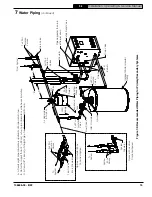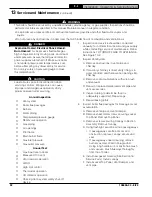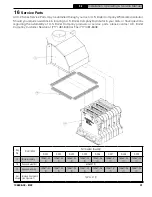
106636-04 - 8/22
29
X-2
Installation, Operating & Service Manual
11
Operation
(continued)
Table 11-6: DHW Terminal Function (
dh_
)
Selection = Domestic Hot Water
Demand, (Parameter
dh
_ =
dh
)
Call for Heat
Priority
Time
(Pt_)
Circulator Status
T-T
Input
DHW
Input
System
Circulator
Output
DHW
Circulator
Output
on
off
On
on
off
on
on
On
off
on
off
on
On
off
on
on
off
off
on
off
on
on
off
on
on
off
on
off
off
on
Table 11-7: DHW Terminal Function (
dh_
)
Selection = Second Heating Zone,
(Parameter
dh
_ =
tt2
)
Call for Heat
Circulator Status
T-T
Input
DHW
Input
System
Circulator
Output
(Zone 1)
DHW
Circulator
Output
(Zone 2)
off
off
off
off
on
off
on
off
on
on
on
on
off
on
off
on
G. Domestic Hot Water (DHW) Terminal Function
(
dh_
)
DHW Circulator output can be connected to
a domestic hot water circulator or a second
heating zone circulator. These applications are
selected as follows:
i. Indirect Water Heater (IWH) (
dh
_is set to
Domestic Hot Water Demand (
dh
))
IWH limit is wired to "DHW" terminal on
control. DHW circulator is wired to "DHW
Circulator" on control wire harness.
Table 11-6 shows circulator status with
different combinations of "TT Input", "DHW
Input", and "Priority Time"
Pre-purge time delay control logic is
bypassed to allow boiler to fire without
delay.
When DHW demands ends, DHW circulator
is de-energized, System Circulator "force
off" is removed (system circulator can
respond normally).
When Priority Time parameter is set to "off"
System Circulator is not forced off for a
DHW call for heat.
ii. Second heating zone (
dh
_ is set to second
heating zone (
tt2
)).
Helpful when home uses only two heating
zones (eliminates need for two circulator
zone panel).
Zone 1 is wired to "Thermostat" connection
on control wire harness.
Zone 2 is wired to "DHW" terminals on
control.
Zone 1 circulator is wired to "System
Circulator" on control wire harness.
Zone 2 circulator is wired to "DHW
Circulator" on control wire harness.
Two circulator outputs are used to control
two independent heating zones and
energize during corresponding call for heat.
See Table 11-7.
















































